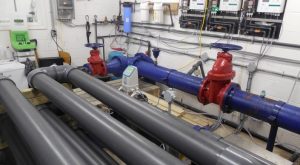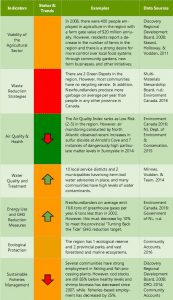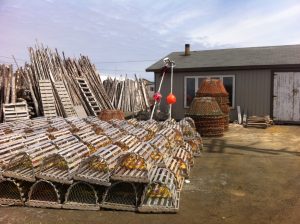Why is This Important?

The Town of Sunnyside’s new hydrogen peroxide-based water treatment system used as a pilot project in 2015. Photo credit: Robert Snook.
At its core, sustainable development means learning to live within the limits of our planet while finding ways to bring our livelihoods into harmony with the environment. The Clarenville-Bonavista-Isthmus region is still recovering from the 1992 groundfish Moratorium and is redefining its relationship with the ocean environment. We face a common challenge to protect both the land and the sea and related livelihoods – like agriculture and fishing – that depend on them, while reducing waste and fighting climate change. Another major challenge for many communities is providing safe drinking water for residents, which can be very difficult for small communities with limited capacity to invest in new water treatment technology. Many local efforts have advanced stewardship and improved environmental health in the region, ranging from community gardens to wetland stewardship agreements. We must celebrate these initiatives and advocate for more support for similar projects in the future.
Key Indicators and Trends

Many factors were examined to understand the region’s progress towards meeting this priority. The first of these was agriculture, which is important both for improving food security and reducing the environmental footprint of shipping food. Agriculture employs a considerable number of people in the region but is still a small part of the regional and provincial economy. This poses a major opportunity for communities throughout NL to  provide more food locally. Waste reduction is a major challenge, with recycling services limited to two green depots that accept limited materials. Air quality is generally very good in the region, although recent concerns about pollutants in communities on the Isthmus have surfaced. Drinking water quality is a continual challenge for many communities facing long-term boil-water advisories, but the recent water treatment pilot in Sunnyside offers hope for other small communities who may be able to adopt similar treatment technology in the near future.
provide more food locally. Waste reduction is a major challenge, with recycling services limited to two green depots that accept limited materials. Air quality is generally very good in the region, although recent concerns about pollutants in communities on the Isthmus have surfaced. Drinking water quality is a continual challenge for many communities facing long-term boil-water advisories, but the recent water treatment pilot in Sunnyside offers hope for other small communities who may be able to adopt similar treatment technology in the near future.

Reducing greenhouse gas emissions is a major priority for communities around the world. Unfortunately, residents of NL generally have a very large contribution to climate change, although this has decreased in recent years. Another top priority for attaining environmental sustainability in the region is protecting sensitive ecosystems. Currently, two communities (Come-by-Chance and Bonavista) are members of the Stewardship Association of Municipalities, which helps communities protect sensitive wetland habitats.

The Skerwink Trail in Port Rexton, one of Hike Discovery’s most popular trails.
One of the region’s greatest assets is the network of nature trails maintained through the Hike Discovery initiative. These trails allow both locals and tourists to visit the Bonavista region’s most unique natural areas and learn about the local environment. Finally, the region’s relationship to fisheries is one of the most vital links between environmental sustainability and social well-being. Historically dependent on the cod fishery, the region continues to struggle from the economic and social crisis brought on by the 1992 Moratorium.

Lobster and crab harvesting gear in Bonavista.
However, many communities are still actively involved in harvesting and processing shrimp, crab, lobster, mussels, and other species. There is renewed interest in bringing back the cod fishery, which has recently begun to show signs of recovery, although stocks are still far below what is considered a healthy level for full commercial exploitation. A major opportunity for place-based development in the region is the revival of the cod fishery using low-impact harvesting methods while exploring linkages to culinary tourism.
Overall Status: Moderate
The region’s relationship with the environment is a complex system affected by many local and global factors. In considering ways for communities to reduce their impact on the ecosystem, it is essential to think about social well-being and economic prosperity as well so that society is not hurt by decisions to protect the environment. The region, much like other parts of NL, has a far way to go in attaining environmental sustainability. Going forward, it is important to think about how new development can take the local environment into account while drawing on the unique identity and character of the region.
